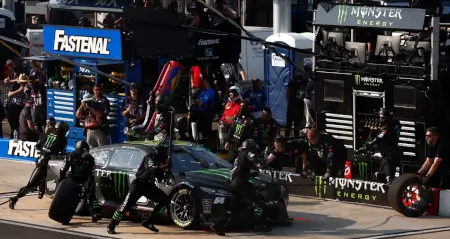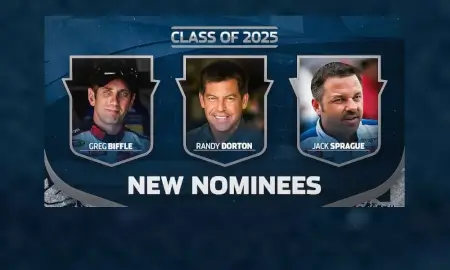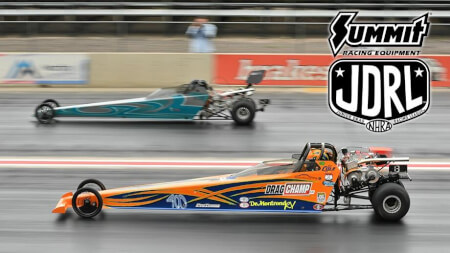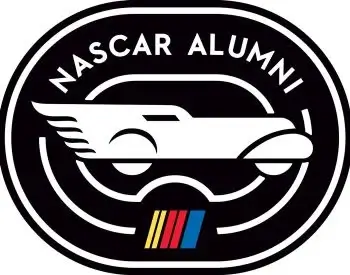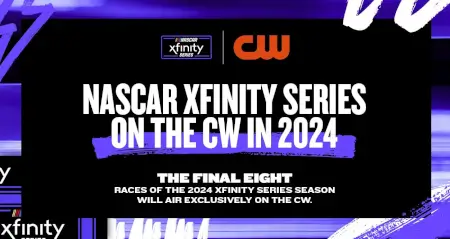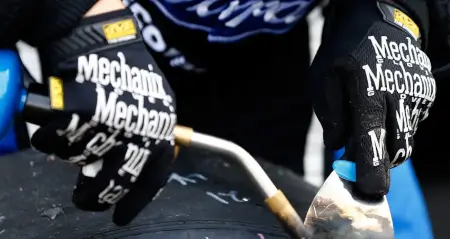April 24th 2024
NASCAR All-Star Race adds tire-strategy choices, new-look qualifying for 2024
NASCAR and Speedway Motorsports officials announced Tuesday the format for this year’s NASCAR All-Star Race, introducing a new strategy element with multiple tire choices and adding a new-look qualifying procedure to the May 19 exhibition event at North Wilkesboro Speedway.
The All-Star Race returns to the historic 0.625-mile oval for the second consecutive year, again with a 200-lap main event (8 p.m. ET, FS1, MRN Radio, SiriusXM NASCAR Radio) and a select field of eligible NASCAR Cup Series drivers bidding for a $1 million payday. But teams will have three types of Goodyear tires on hand — a baseline “prime” tire, a softer “option” tire, and wet-weather tires should conditions warrant.
The prime tire was developed through Goodyear testing at the repaved track last month and will have the conventional yellow lettering on the sidewalls. The option tire — which will have distinctive red sidewall lettering — uses the same rubber compound as the wet-weather tires in a slick, providing improved short-term grip but more rapid wear. Teams will be required to qualify on the prime tire and start the main event on the option tire; tire changes beyond those times will be the teams’ choice.
The use of tire alternatives comes as NASCAR competition officials explore ways to enhance the series’ short-track package and in the wake of a March 17 race at Bristol Motor Speedway where increased tire wear produced an intriguing strategy twist. At Bristol, teams and drivers were forced to manage their tires — conserving them to prolong their life, or pushing forward at the risk of blistering or failure.
The non-points event provides an opportunity for competition officials to launch a low-risk trial balloon, says NASCAR Senior Vice President and Chief Racing Development Officer John Probst, who added “never say never” about the format’s potential for future races.
“I would say that we’ve often used the All-Star Race in the past to try some things,” Probst said last weekend at Talladega Superspeedway. “It’s an opportunity for us without the pressure of points being paid, and certainly … with the cooperation of Goodyear and our teams, in this case, a chance to just try something. When we were at Bristol, we certainly saw a very entertaining race there when tire wear became something they had to manage, and so it’s just an opportunity for us to try it. If it does look good, we will certainly consider it.”
Eligible drivers include Cup Series points-race winners from this season and last year, previous All-Star Race winners competing full time, and past Cup champions who also race full time. The top two finishers from Sunday’s 100-lap All-Star Open preliminary qualifying race (5:30 p.m. ET, FS1, MRN Radio, SiriusXM NASCAR Radio) will transfer into the main event, and a final berth will be determined by the results of fan voting, which is now open.
Friday’s qualifying sessions will set the starting lineups for both the Open and for a pair of 60-lap heats scheduled Saturday that will establish the All-Star Race’s lineup.
The 200-lap main event will have two breaks this year — one at the halfway point and another at Lap 150 with the following rules, allotments, and other details for the tires:
— Teams will have nine sets of tires for the weekend — five sets of primes, four sets of options. Teams will have three sets of primes and two sets of options for the preliminaries (practice, qualifying, heats, Open), and two sets each of primes and options for the main event.
— Teams must use all four tires of the same type at all times — no mismatching, for instance, of left-side primes and right-side options.
— Qualifying for both the All-Star Open and the All-Star Race will be conducted on prime tires.
— Teams may select either tire type for the start of practice, heats and the Open.
— Teams must start the All-Star Race on option tires. Teams must also make a pit stop for four tires at the midpoint break of the qualifying heats, the Open, and the All-Star Race.
Friday’s qualifying for eligible All-Star Race competitors will have a different structure this year, with the Pit Crew Challenge incorporated into the format. Drivers will take the green flag to start their qualifying attempt and run one lap at speed. On the second lap, the driver will bring the car to pit road at the pit-lane speed limit for a four-tire stop and mock fuel delivery, then complete the qualifying attempt by returning to the track and racing back to the checkered flag. Total elapsed time will determine the pole starter for both the All-Star Race and the first heat.
Friday’s qualifying for eligible All-Star Race competitors will have a different structure this year, with the Pit Crew Challenge incorporated into the format. Drivers will take the green flag to start their qualifying attempt and run one lap at speed. On the second lap, the driver will bring the car to pit road at the pit-lane speed limit for a four-tire stop and mock fuel delivery, then complete the qualifying attempt by returning to the track and racing back to the checkered flag. Total elapsed time will determine the pole starter for both the All-Star Race and the first heat.
The Pit Crew Challenge will be judged from a pair of timing lines near the designated pit boxes — one pit stall before and one pit stall after. The team with the fastest penalty-free stop between the timing lines will be crowned as the Pit Crew Challenge winner, and the results will determine pit-stall selection order for the main event.
“That’s a way we thought would be a good reward beyond the monetary recognition and the bragging rights you get by winning the pit-stop competition,” Probst says, “but then also that group of guys can affect where their team pits during the All-Star Race.”
The format was developed in coordination with Speedway Motorsports President and CEO Marcus Smith, who helped bring the North Wilkesboro track back to life after 26 years of near dormancy. Further vetting of the format was provided by Kevin Harvick, a two-time All-Star Race winner during his driving days who will help call this year’s festivities from the FOX Sports booth.
“As we were bringing this all together, in addition to consulting Goodyear and the teams, we wanted to bounce off some more ideas, and Marcus has always been willing to innovate on the side of if it’s aero packages, or different formats, or reconfiguring of race tracks,” Probst said. “He’s always been a proponent of innovating and trying things in the All-Star Race, and this was an example of working with Goodyear and SM to come up with some solutions. We ran them by Kevin in Texas, just to get his feel on it and made some modifications based on feedback that he gave us, as far as how long we’d have those stages, if you will, for the All-Star break and what tires they should be on. So thanks to them for just providing the input as far as how we were going to do this.”
NASCAR officials provided an option-tire choice during the All-Star Race in 2017, but the experiment made only minimal difference in performance or wear. Probst said that the softer tire used seven years ago produced lap times nearly half a second faster at Charlotte Motor Speedway; at North Wilkesboro, Probst said, such a gain would be more pronounced at a track that’s more than twice as short as Charlotte’s 1.5-mile layout. Probst also indicated that tire falloff was expected to be more dramatic this year.
Even though NASCAR has used softer-compound tires in a previous All-Star events on an intermediate-sized track, Probst said the primary target for a more aggressive tack with tires remains the circuit’s short tracks — using 1.366-mile Darlington Raceway as an unofficial dividing line between those track types.
“The moment we get over into the Darlington, mile-and-a-half-type stuff, that’s a little bit different beast and arguably right now some of the best racing we have going on,” Probst says. “So I think we would tread pretty lightly when we got into say, Darlington and above, but certainly that Darlington and below are tracks right now that are squarely in our focus for development of tires. I’ve learned long ago, never say never, never say always, but if this works, we will experiment with it on the bigger tracks, but it will probably be at a test, not in any kind of points or even exhibition race to start.”
Probst applauded Goodyear’s willingness and flexibility to experiment with different tire choices, but also noted the tiremaker’s diligence in developing the All-Star weekend rubber on an accelerated timetable.
“It’s always difficult to ask your tire partner to build a tire like this, because they build great tires, and we’re asking them to actually build a tire that’s going to wear out and maybe fail ultimately if the teams drive it too hard for too long,” Probst said. “So we’re actually trying to thread the needle of making entertaining racing without the tire becoming the overwhelming story from a failure perspective, because in a way it’s what we’re asking for, but Goodyear as a company is not going to want to be seen with their tires failing even though that’s what we’re asking for. So we’ve been asking them to do things that probably make them a little uncomfortable to do from a corporation, but they have been phenomenal to work with.
“Everything we’ve asked them to do, they’re willing to consider and in this case, we’re taking advantage of a non-points race to get a little aggressive. If this works well, then we’ll continue to take steps in this direction and just keep walking down a path of trying to get the tires to really wear out and have to be managed.”
For more Industry News, please Click Here
For more Industry News, please Click Here
